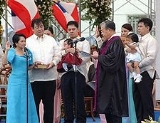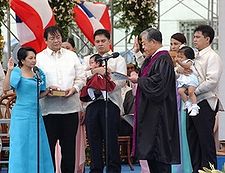
Philippine presidential inauguration
Encyclopedia

President of the Philippines
The President of the Philippines is the head of state and head of government of the Philippines. The president leads the executive branch of the Philippine government and is the commander-in-chief of the Armed Forces of the Philippines...
.
Inaugural Ceremonies

At the inauguration venue, the incumbent president will be welcomed with arrival honors. Then, a symbolic shake of hands between the president-elect and the incumbent president will be shown to the public. The incumbent president will then leave the inauguration venue riding a private vehicle. From there, the proper inauguration rites will take place. that includes The National Anthem will be play, and some Ecumenical Invocation and Musical Ensemble . This tradition was broken by Fidel Ramos on June 30, 1992, where Corazon Aquino stayed until the end of the inaugural speech. The same was observed by Joseph Estrada on June 30, 1998. For the third time, it was also observed once more by Benigno Aquino III.
Traditionally, since the third republic, the vice-president-elect takes the oath of office first before the president-elect to immediately establish a constitution-mandated successor. However, during the inauguration of Manuel L. Quezon
Manuel L. Quezon
Manuel Luis Quezón y Molina served as president of the Commonwealth of the Philippines from 1935 to 1944. He was the first Filipino to head a government of the Philippines...
, the president-elect took the oath of office first to mark a "new start". After the vice-president took the oath of office, it is the turn of the president-elect. A 21-gun salute is performed and the Four Ruffles and Flourishes and presidential anthem "We Say Mabuhay" is played as soon as the new president took the oath of office in honoring him as the new chief executive. Then the newly declared President delivered his/her Inaugural Address.
After the ceremonies a formal possession of Malacañang, which is the president's official residence, takes place. It symbolizes the new tenancy of the palace. Images associated with the new President's formal entry into the Palace is that of him or her ascending the grand staircase leading to the Ceremonial Hall. Juan Luna's painting, the Blood Compact is currently displayed at the at the top of the staircase.
The president's new cabinet is inducted on the same day. the first Cabinet meeting will follow.
Inaugural Reception for foreign and other dignitaries who wish to call on the new President. The term vin d'honneur
Vin d'honneur
Vin d'honneur literally translates from French to "Wine of honour" and is akin to a prolonged social celebration after an official ceremony like a marriage....
will no longer be used, reverting to the premartial law practice of simpler official receptions. There will also be no Inaugural Ball (the last Inaugural Ball was for the 1981 Marcos inaugural, which was also the last time the Rigodon de Honor was danced in the Palace until June 12, 2009, when it was again danced on June 12 of that year). The President of the Philippines will offer a toast as a gesture of amity to the nations that maintain diplomatic relations with the Philippines.
Dates
The new president is to be inaugurated at noon of June 30 as mandated by the 1987 consititution. However, in the past, there were different dates for the inauguration of the new president. The nation's first president, Emilio AguinaldoEmilio Aguinaldo
Emilio Aguinaldo y Famy was a Filipino general, politician, and independence leader. He played an instrumental role during the Philippines' revolution against Spain, and the subsequent Philippine-American War or War of Philippine Independence that resisted American occupation...
, was inaugurated on January 23, 1899. Presidents under the 1935 constitution presidents were inaugurated at noon of December 30. They were Manuel L. Quezon
Manuel L. Quezon
Manuel Luis Quezón y Molina served as president of the Commonwealth of the Philippines from 1935 to 1944. He was the first Filipino to head a government of the Philippines...
(first inaugurated on November 15, 1935, inaugurated for a second term on December 30, 1941), Quirino (1949), Ramon Magsaysay
Ramon Magsaysay
Ramón del Fierro Magsaysay was the third President of the Republic of the Philippines from December 30, 1953 until his death in a plane crash in 1957. He was elected President under the banner of the Nacionalista Party.-Early life:Ramon F...
(1953), Carlos P. Garcia
Carlos P. Garcia
Carlos Polistico García was a Filipino teacher, poet, orator, lawyer, public official, political economist and guerrilla leader...
(1957), Diosdado Macapagal
Diosdado Macapagal
Diosdado Pangan Macapagal was the ninth President of the Philippines, serving from 1961 to 1965, and the sixth Vice President, serving from 1957 to 1961. He also served as a member of the House of Representatives, and headed the Constitutional Convention of 1970...
(1961) and Ferdinand E. Marcos
Ferdinand Marcos
Ferdinand Emmanuel Edralin Marcos, Sr. was a Filipino leader and an authoritarian President of the Philippines from 1965 to 1986. He was a lawyer, member of the Philippine House of Representatives and a member of the Philippine Senate...
(1965, 1969). Only 2 president under the 1935 constitution was not inaugurated on December 30, namely, Osmeña and Roxas. However, Marcos changed the inauguration date to June 30 and every president after him, except Corazon C. Aquino
Corazon Aquino
Maria Corazon Sumulong Cojuangco-Aquino was the 11th President of the Philippines and the first woman to hold that office in Philippine history. She is best remembered for leading the 1986 People Power Revolution, which toppled Ferdinand Marcos and restored democracy in the Philippines...
, was inaugurated on that date.
Location

Other presidents such as Aguinaldo and Estrada were inaugurated at the Barasoain Church
Barasoain Church
Barasoain Church is a Roman Catholic church built in 1630 in Malolos City, Bulacan. Having earned the title as the Cradle of Democracy in the East, the most important religious building in the Philippines, and the site of the First Philippine Republic, the Church is proverbial for its historical...
; Quezon, Laurel and Roxas were inaugurated in front of the Legislative Building; and Aquino in Club Filipino, Greenhills, San Juan, Metro Manila. Arroyo took her first oath as president at the EDSA Shrine in Quezon City
Quezon City
Quezon City is the former capital and the most populous city in the Philippines. Located on the island of Luzon, Quezon City is one of the cities and municipalities that make up Metro Manila, the National Capital Region. The city was named after Manuel L...
. Presidents, who became president upon the death of their predecessor, namely, Osmeña took the oath of office in the United States, Quirino and Garcia took the oath of office in the Malacañan Palace
Malacañang Palace
The Malacañan Palace, commonly known simply as Malacañang, is the official residence and principal workplace of the President of the Philippines. Located at 1000 J. P. Laurel Street, San Miguel, Manila, the house was built in 1750 in Spanish Colonial style. It has been the residence of every...
.
Attendees
In addition to the public the following are the attendants of the Inauguration:- The President and Vice-President-elects and their families
- Members of The Philippine Congress
- Members of the President's CabinetCabinet of the PhilippinesThe Cabinet of the Philippines consists of the heads of the largest part of the executive branch of the national government of the Philippines...
- Justices of the Supreme CourtSupreme Court of the PhilippinesThe Supreme Court of the Philippines is the Philippines' highest judicial court, as well as the court of last resort. The court consists of 14 Associate Justices and 1 Chief Justice...
- Local Officials
- Representatives of Different Countries and Organizations
- usually the outgoing president and vice-president
- Choir and Orchestra
- Security headed by the Presidential Security GroupPresidential Security Group- External links :*...
Oaths of office
Under Article 7, Section 5 of the Philippine Constitution, before the president and vice-president enters on the execution of his/her office, the President shall take the following oath or affirmation:[In case of affirmation, last sentence will be omitted]
The oath from the Filipino language
Filipino language
This move has drawn much criticism from other regional groups.In 1987, a new constitution introduced many provisions for the language.Article XIV, Section 6, omits any mention of Tagalog as the basis for Filipino, and states that:...
version of the constitution was used for the inauguration of Presidents Fidel V. Ramos
Fidel V. Ramos
Fidel "Eddie" Valdez Ramos , popularly known as FVR, was the 12th President of the Philippines from 1992 to 1998. During his six years in office, Ramos was widely credited and admired by many for revitalizing and renewing international confidence in the Philippine economy.Prior to his election as...
, Joseph Estrada
Joseph Estrada
Joseph "Erap" Ejercito Estrada was the 13th President of the Philippines, serving from 1998 until 2001. Estrada was the first person in the Post-EDSA era to be elected both to the presidency and vice-presidency.Estrada gained popularity as a film actor, playing the lead role in over 100 films in...
and Benigno Aquino III
Benigno Aquino III
Benigno Simeon Cojuangco Aquino III , also known as Noynoy Aquino or PNoy, is a Filipino politician who has been the 15th and current President of the Philippines since June 2010....
:
(Kapag pagpapatotoo, ang huling pangungusap ay kakaltasin.)
Traditionally, the oath of office is administered by the Chief Justice of the Philippine Supreme Court but that is not required.
Inaugural Address
Every president since Emilio AguinaldoEmilio Aguinaldo
Emilio Aguinaldo y Famy was a Filipino general, politician, and independence leader. He played an instrumental role during the Philippines' revolution against Spain, and the subsequent Philippine-American War or War of Philippine Independence that resisted American occupation...
delivered an inaugural address. Presidents, who became president upon the death of their predecessor, also delivered an address. It is usually delivered after the new president took the oath of office. However, President Gloria Macapagal-Arroyo
Gloria Macapagal-Arroyo
Gloria Macapagal-Arroyo is a Filipino politician who served as the 14th President of the Philippines from 2001 to 2010, as the 12th Vice President of the Philippines from 1998 to 2001, and is currently a member of the House of Representatives representing the 2nd District of Pampanga...
delivered the inaugural address first at the Quirino Grandstand and then took the oath of office in Cebu
Cebu
Cebu is a province in the Philippines, consisting of Cebu Island and 167 surrounding islands. It is located to the east of Negros, to the west of Leyte and Bohol islands...
.

